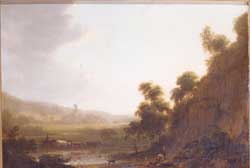 |
 |
 |
 |
 |
 |
 |
|
Difficult Times (7/15) After 1210 benefactions to Kirkstall waned, a situation experienced by other Cistercian communities throughout the country. From this time the community was also increasingly embroiled in litigation and disputes relating to the management and protection of its possessions. In 1292, for example, John Sampson pressed charges against two of the abbot’s men, John of Kirkstall and Adam the Hunter, whom, he claimed, had seized and retained his iron hammer on Eccup Moor. Sampson demanded forty shillings recompense. John and Adam maintained that Sampson should not have been working the soil there which belonged to the abbot and that they, as the abbot’s bailiffs, had a right to take action. Sampson defended his actions and maintained that the abbot and convent had enfeoffed him of two carucates of land in Touhouses (Tofthouse), which gave him the right to take stones from the moor for building.(9)
The process of administering, consolidating and protecting the abbey’s holdings could clearly be time-consuming and expensive. It has been estimated that from 1260 to1517 there were about forty legal cases relating to those who had damaged the abbot’s woods, crops or pastures, seized the community’s cattle, committed trespass on their property, or made waste of houses and gardens; and of course not every incident came to court.(10)
|
